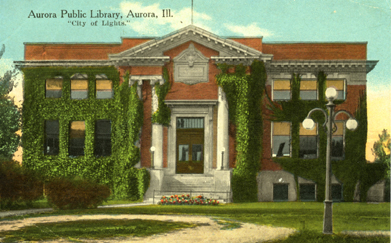|

October 19, 2020
#338
Thank you,
Barbara Schock, for sharing your extraordinary gift of these vignettes of Galesburg &
19th century American history.

Aurora Public Library, Aurora, Illinois ca.1900 |
Aurora, Illinois By Barbara
Schock
During the winter of 1905 Carl Sandburg spent time in
Aurora, Illinois. He sold stereoscopic views door-to-door to support himself. He
was always successful in that line of work when he applied himself to it.
He lived in a single room without heat or plumbing which
cost a dollar a week. Some mornings he had to break the ice in the water pitcher
in order to take a sponge bath. He used a Sterno stove to boil two eggs for
breakfast and used the hot water to make cocoa. A slice or two of bread and an
apple or orange completed his breakfast. He would eat a light lunch and go to a
restaurant for a substantial evening meal.
He was being called to his life work as a writer. He
spent many hours in the Aurora Public Library in the center of the city reading
his way through the works of other writers. He wrote every kind of poetry and
tried many experiments to get to his own writing style.
Sandburg also tried the vaudeville stage playing an
immigrant with a Swedish accent. He was funny and the manager of the small
theater told him he could make a success of it with practice. That wasn’t the
true aim of his life.
Aurora is located on the Fox River in the southeast
corner of Kane County. The village was platted in 1836 by Joseph and Samuel
McCarthy who came from New York state. They dammed the river and built a
sawmill. The original name of the village was Waubonsee in honor of a friendly
Indian chief. (Today Waubonsee Community College carries the historic name and
is located a few miles west of the city.) Another place had the same name so
Aurora, the Roman goddess of light, was adopted as the city’s name. Today,
Aurora has expanded into the neighboring counties of DuPage, Will and Kendall.
The population is more than 200,000.
In 1856 the Chicago, Burlington and Quincy Railroad
established a round house and locomotive shop in Aurora. It was the largest
employer in the city until the 1960s. Because of the shipping access Aurora
became a manufacturing powerhouse. Immigrants from Ireland, Great Britain,
Scandinavia, Luxembourg, Germany, France and Italy combined to make Aurora a
dynamic city.
Carl’s brother Mart worked for the Adams Express Company
and had charge of a railroad car from Chicago to Galesburg. It would stop five
or ten minutes in Aurora so Carl rode a few times to Galesburg with him. On one
trip Mart told Carl there was a job at the Brooks Street fire station. It
required two hours a day taking care of the horses plus any fires that might
happen. It was the perfect solution for a young man trying to be a writer.
|
